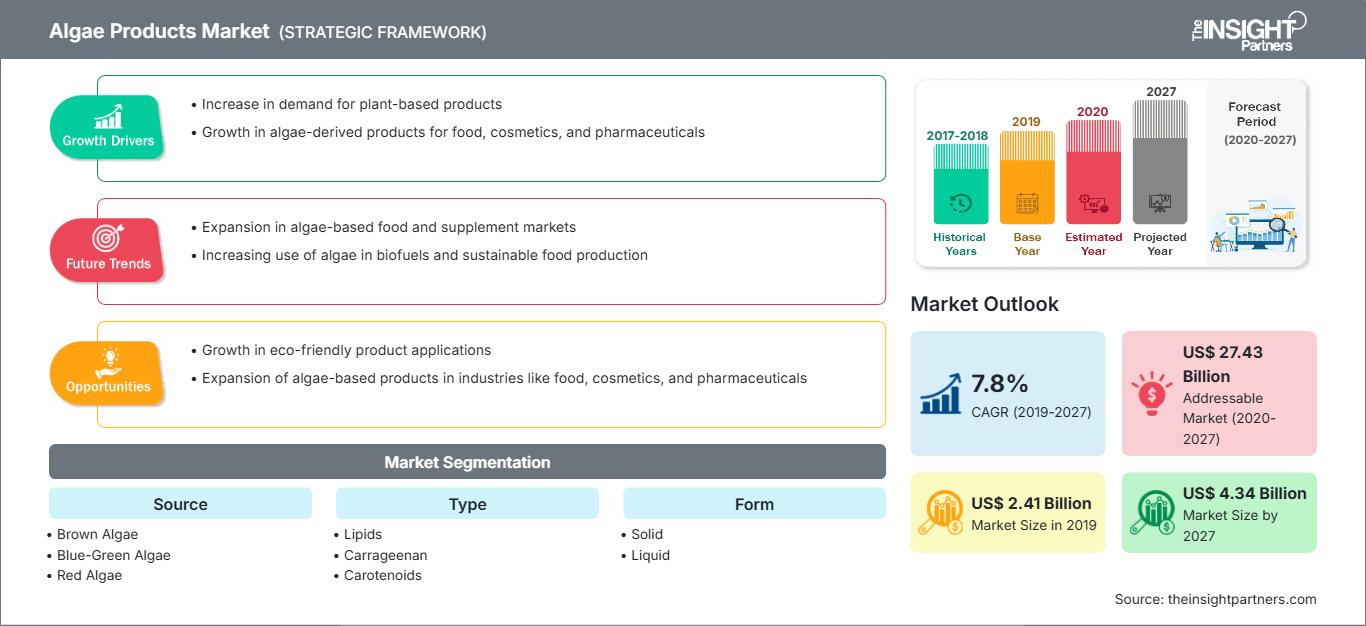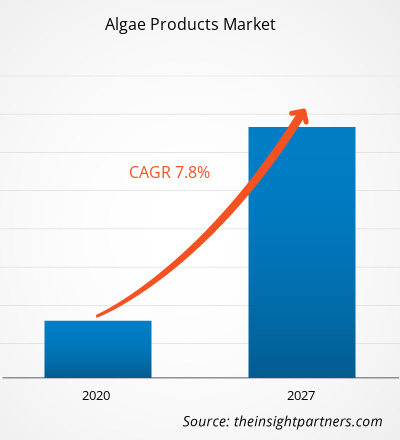[調査レポート]藻類製品市場は2019年に24億550万米ドルと評価され、2027年には43億3930万米ドルに達すると予測されています。また、2020年から2027年にかけて年平均成長率7.8%で成長すると見込まれています。
藻類は、多くの利点と生産の容易さから、燃料、食料、飼料、バイオマスや油の副産物として、最も有望な長期的かつ持続可能な供給源の一つとして浮上しています。藻類は、他の既知の自然または人工のプロセスとは異なり、10億年以上かけて効率的にエネルギーを生産・貯蔵するように進化してきました。さらに、微細藻類は、バイオ燃料や動物飼料、またはその両方を生産するために、タンパク質と油分を多く含むように栽培することができます。さらに、微量栄養素が豊富な微細藻類バイオマスは、すでに人間の健康を改善するための栄養補助食品に使用されています。食品市場における最も重要な用途は、微細藻類バイオマス全体を食品サプリメントとして利用することです。微細藻類は、カロテノイドやオメガ3脂肪酸などの食品成分の供給源としても利用されています。同様に、寒天は食品業界ではゼラチンの代替品として使用され、クリーム、ソース、マヨネーズ、ゼリー、カスタード、プリン、プロセスチーズ、冷凍乳製品の製造に使用されています。また、ジャムやマーマレードのゲル化および増粘剤として、またパンやペストリーの乾燥防止剤としても使用されています。さらに、寒天はアイスクリームなどのデザートの増粘剤としても使用されています。このように、藻類製品は代替食料源および食品成分として機能し、藻類製品市場の成長を牽引しています。
2019年には北米が最大の市場シェアを占めました。さらに、アジア太平洋地域は予測期間(2020年から2027年)において高い成長率を示すことが予測されています。米国をはじめとする世界各地では、藻類は免疫力の強化、神経組織の修復、血糖値の正常化、そして体へのタンパク質と食物繊維の供給を助ける栄養補助食品として広く利用されています。中国と日本では、4,000年以上前から藻類が食用として採取されてきました。
要件に合わせてレポートをカスタマイズ
レポートの一部、国レベルの分析、Excelデータパックなどを含め、スタートアップ&大学向けに特別オファーや割引もご利用いただけます(無償)
藻類製品市場: 戦略的洞察

- このレポートの主要な市場動向を入手してください。この無料サンプルには、市場動向から見積もりや予測に至るまでのデータ分析が含まれます。
COVID-19パンデミックによる藻類製品市場への影響
レポートの一部、国レベルの分析、Excelデータパックなどを含め、スタートアップ&大学向けに特別オファーや割引もご利用いただけます(無償)
藻類製品市場: 戦略的洞察

- このレポートの主要な市場動向を入手してください。この無料サンプルには、市場動向から見積もりや予測に至るまでのデータ分析が含まれます。
米国は、カナダやメキシコと比較して、コロナウイルスの確認症例数が最も多いです。パンデミックCOVID-19は、北米諸国の小売店や製造工場の一時的な閉鎖を余儀なくし続けており、前例のない商業の混乱を示しています。小売業者やブランドは、健康と安全、サプライチェーン、労働力、キャッシュフロー、消費者需要、マーケティングなど、さまざまな短期的な課題に直面しています。北米では3月初旬に店舗の閉鎖が始まり、都市や州がウイルスの蔓延を阻止しようと奮闘する中、この傾向は続くと予想されます。さらに、COVID-19パンデミックは、デジタルコマースの伝統を急速に加速させています。人々が社会的距離を保つよう勧告される中、医薬品や必需品の食品・飲料のeコマース注文は、北米の人々にとって生き残るための手段となっています。
市場洞察:バイオ燃料市場における急成長
過去10年間、藻類業界はバイオ燃料市場の維持に苦戦してきました。しかし、メーカーが原材料製造、資本コスト、生産量に関連する重要な障壁を克服すれば、この製品は大きな可能性を秘めています。世界的なバイオ燃料義務化の導入により、メーカーは予測期間中に藻類燃料生産のための持続可能な技術を開発するために、研究開発への投資を増やすことが予想されます。さらに、バイオ燃料は、世界的なエネルギー危機と環境問題に対処するための最も有望な再生可能エネルギー源の1つと考えられています。微細藻類バイオマスは、バイオ燃料、化学薬品、バイオベース製品の処理能力を示しており、石油ベース経済からバイオベース経済への移行に貢献しています。藻類バイオ燃料は、食物との競合がなく成長率が高く、環境への影響が最小限または全くないなどの利点があります。微細藻類から生産されるバイオ燃料は、高カロリーのセルロース系バイオ燃料と比較して粘度と密度が低いため、藻類バイオ燃料は用途に適しています。
情報源に基づく市場分析
情報源によると、藻類製品市場は、褐藻、藍藻、紅藻、緑藻、その他に分類されています。2019年には、褐藻セグメントが藻類製品市場を牽引しました。
タイプに基づく市場分析
藻類製品市場は、タイプに基づいて脂質、カラギーナン、カロテノイド、アルギン酸塩、藻類タンパク質、その他に分類されています。 2019年の藻類製品市場は、カロテノイドセグメントが牽引しました。
形態ベースの市場分析
藻類製品市場は、形態に基づいて固体と液体に細分化されています。2019年の藻類製品市場は、固体セグメントが牽引しました。
用途ベースの市場分析
藻類製品市場は、用途に基づいて、食品・飲料、栄養補助食品・栄養補助食品、パーソナルケア製品、飼料、医薬品、その他に分類されています。2019年の藻類製品市場は、栄養補助食品・栄養補助食品セグメントが牽引しました。
有機的成長戦略は、企業が市場規模を拡大するために一般的に採用されている戦略です。 Cyanotech Corporation、DSM、および Algatech Ltd は、顧客基盤を拡大し、世界的に大きな市場シェアを獲得し、その結果として世界の藻類製品市場で自社のブランド名を維持できるようにするためにこの戦略を実行している市場プレーヤーの一部です。
藻類製品市場の地域別分析
予測期間を通じて藻類製品市場に影響を与える地域的な傾向と要因については、The Insight Partnersのアナリストが詳細に解説しています。このセクションでは、北米、ヨーロッパ、アジア太平洋、中東・アフリカ、中南米における藻類製品市場のセグメントと地域についても解説しています。
藻類製品市場レポートの範囲
| レポート属性 | 詳細 |
|---|---|
| の市場規模 2019 | US$ 2.41 Billion |
| 市場規模別 2027 | US$ 4.34 Billion |
| 世界的なCAGR (2019 - 2027) | 7.8% |
| 過去データ | 2017-2018 |
| 予測期間 | 2020-2027 |
| 対象セグメント |
By 発生源
|
| 対象地域と国 | 北米
|
| 市場リーダーと主要企業の概要 |
|
藻類製品市場のプレーヤー密度:ビジネスダイナミクスへの影響を理解する
藻類製品市場は、消費者の嗜好の変化、技術の進歩、製品の利点に対する認知度の高まりといった要因によるエンドユーザーの需要増加に牽引され、急速に成長しています。需要の増加に伴い、企業は製品ラインナップの拡充、消費者ニーズへの対応のための革新、そして新たなトレンドの活用を進めており、これが市場の成長をさらに加速させています。

- 入手 藻類製品市場 主要プレーヤーの概要
- 褐藻
- 藍藻
- 紅藻
- 緑藻
- その他
藻類製品市場 - タイプ別
- 脂質
- カラギーナン
- カロテノイド
- アルギン酸塩
- 藻類タンパク質
- その他
藻類製品市場 - 形態別
- 固体
- 液体
藻類製品市場 - 用途別
- 食品および飲料
- 栄養補助食品および栄養補助食品
- パーソナルケア製品
- 飼料
- 医薬品
- その他
会社概要
- Algatechnologies Ltd
- Algenol
- BASF SE
- Cargill Incorporated.
- Cellana Inc.
- Corbion nv
- CP Kelco (JM Huber- Corporation
- Cyanotech Corporation.
- DSM Nutritional Products AG
- EID Parry Limited
- 過去2年間の分析、基準年、CAGRによる予測(7年間)
- PEST分析とSWOT分析
- 市場規模価値/数量 - 世界、地域、国
- 業界と競争環境
- Excel データセット
最新レポート
お客様の声
購入理由
- 情報に基づいた意思決定
- 市場動向の理解
- 競合分析
- 顧客インサイト
- 市場予測
- リスク軽減
- 戦略計画
- 投資の正当性
- 新興市場の特定
- マーケティング戦略の強化
- 業務効率の向上
- 規制動向への対応




















 無料サンプルを入手 - 藻類製品市場
無料サンプルを入手 - 藻類製品市場